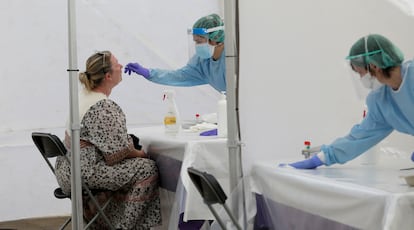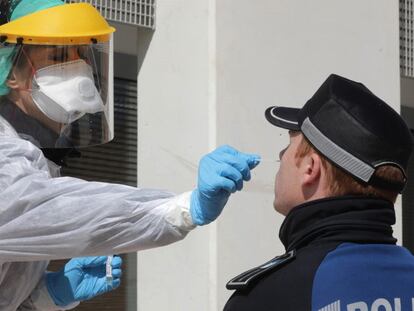Coronavirus cases in Spain: 40% under the age of 40 and more than half asymptomatic
The latest report from the Carlos III Health Institute reveals that 49.6% of patients did not know they had been in contact with someone with Covid-19


Spain is detecting an increasing number of young people with Covid-19, according to a new report by the Carlos III Health Institute. The study, published Monday night, showed that most new cases fall in the 15-to-29 age bracket. Two out of every 10 infections recorded since May 10, when Spain began to roll back its lockdown rules, were adolescents or young adults. Indeed, of the 25,600 cases analyzed in the report, 40% were under the age of 40. The average age of coronavirus patients has fallen from around 60 in April to 48, according to the epidemiological survey Covid-19 Situation in Spain, which is based on the information provided by regional authorities when a new case is detected.
The coronavirus situation in Spain has changed a lot in the past few months. On April 1, 83.3% of all cases were over the age of 40. At that point, tests were only being carried out on patients with serious symptoms who had been hospitalized. Now PCR tests have become widespread, and are recommended for anyone experiencing symptoms or who have been in contact with a coronavirus case. Thanks to this change, a large number of asymptomatic cases are being detected in Spain. According to the report, 55% of cases never experienced any coronavirus symptoms.
According to the survey, 37% of patients did not know where they contracted the virus
What’s still unclear is the source of contagion. According to the survey, 37% of patients did not know where they contracted the virus. The poll showed that one in four (25%) of infections happened in the home, 12.1% in social service residences, 11.1% in the workplace and 6.1% in medical centers. Also listed were 25 cases (0.2% of the total) that occurred at schools, while another 7.3% were categorized as “other.”
The report also found that an average of 49.6% of patients had no known prior contact with another Covid-19 case. In other words, half of all respondents were not aware that they had been in contact with someone with the virus or were not able to establish a clear link. This is not a good figure, says Jesús Molina Cabrillana, the spokesperson of the Spanish Association of Preventive Medicine, Public Health and Hygiene, who explains: “It should be as low as possible.” “If it is zero it means that all the cases have a known contact and the traceability [of the contagion] is well defined,” he adds.
But this figure varies significantly between Spain’s 17 regions. In Catalonia, the report found that three in four cases (74.4%) had not had any contact with someone with Covid-19. This indicates that in some areas in the region, there is community transmission of the virus and contact tracing is not being effective. Indeed, Catalonia is one of the regions that did not provide data on how many contacts are identified for each coronavirus case. “The current situation in Catalonia is bad. There is community transmission,” says Molina Cabrillana.
In the Basque Country, only 11.9% of cases did not have contact with another coronavirus case. This figure was also low in Andalusia, Canary Islands and Aragón, where it was around 20%.
According to the survey, an average of four contacts are being identified for every new contagion. This figure was incorrectly reported as one contact in the previous report, which was published last Friday. The new version also contains data from Asturias, Castilla-La Mancha, Catalonia and Madrid that had not been included due “difficulties in categorizing the variables.”
“It’s easy to report [the figures] and I find it strange that four regions have problems categorizing it,” says Molina Cabrillana. Some data from the Balearic Islands and Cantabria is also missing, but without any explanation. The figures that have been provided show that six contacts are being identified for every new case in the Balearic Islands, compared to two in La Rioja.
107 imported cases in two days
According to the survey, imported cases represent 1.9% of total infections in Spain. Since the beginning of the deescalation process, 435 have been recorded. It is not possible to compare the reports from March and May (they stopped being published in June and the first half of July) because they did not include this information. But it is possible to compare the two latest reports, published last Friday and Monday, with data from July 15 and July 17, respectively. The first survey recorded 328 imported cases, and the second, 435. This means that 107 new imported cases were detected in just two days.
Several of the active coronavirus outbreaks in Spain are linked to imported cases. In Murcia, one outbreak began after two passengers arrived on a plane from Bolivia; several cases have been recorded among migrant arrivals in the Canary Islands; and in the Balearic Islands, several tourist families have also tested positive for the virus.
According to the report, 0.8% of the 25,600 cases died from the disease, 8.5% required hospitalization and 0.6% were admitted into intensive care. The survey also showed that health and social services workers made up 11% of cases.
English version by Melissa Kitson.
Tu suscripción se está usando en otro dispositivo
¿Quieres añadir otro usuario a tu suscripción?
Si continúas leyendo en este dispositivo, no se podrá leer en el otro.
FlechaTu suscripción se está usando en otro dispositivo y solo puedes acceder a EL PAÍS desde un dispositivo a la vez.
Si quieres compartir tu cuenta, cambia tu suscripción a la modalidad Premium, así podrás añadir otro usuario. Cada uno accederá con su propia cuenta de email, lo que os permitirá personalizar vuestra experiencia en EL PAÍS.
¿Tienes una suscripción de empresa? Accede aquí para contratar más cuentas.
En el caso de no saber quién está usando tu cuenta, te recomendamos cambiar tu contraseña aquí.
Si decides continuar compartiendo tu cuenta, este mensaje se mostrará en tu dispositivo y en el de la otra persona que está usando tu cuenta de forma indefinida, afectando a tu experiencia de lectura. Puedes consultar aquí los términos y condiciones de la suscripción digital.
More information
Últimas noticias
Most viewed
- Sinaloa Cartel war is taking its toll on Los Chapitos
- Reinhard Genzel, Nobel laureate in physics: ‘One-minute videos will never give you the truth’
- Oona Chaplin: ‘I told James Cameron that I was living in a treehouse and starting a permaculture project with a friend’
- Why the price of coffee has skyrocketed: from Brazilian plantations to specialty coffee houses
- David King, chemist: ‘There are scientists studying how to cool the planet; nobody should stop these experiments from happening’









































